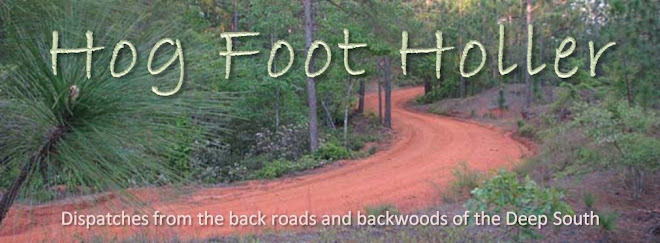Alabama's last old growth longleaf, 1963. Click to enlarge.
I recently found this photo in an
old file drawer, and I don't think it has been digitized before. The photographer is not given. Written in pencil on the back is "Hauss Park Old Growth Longleaf
near Flomaton, AL 1963." This once-spectacular 60-acre remnant of Alabama's forest history is gone forever. In 2008 the
tract was divested by the Birmingham-based forest management company that owned it to an adjacent landowner who then clear-cut it. The day I found out, I contacted a friend in the company who assured me they contacted various potential conservation buyers, organizations, and individuals to see if they had an interest in buying the property, but I know many in the conservation community were taken by complete surprise when it was cut. It could have and should have been saved. Below is a description, taken from an Alabama Forestry Commission web page that is no longer accessible:
The 60-acre area was well known, well researched, and well used. What made this forest biologically unique is that it was well over 3 centuries old and was among the last parcel of land of its kind in the world (only a few other virgin longleaf pine stands remain across 9 southern states; and now no more of its kind in Alabama). To put it another way, this one forest was over 100 years old before Alabama became a state in 1819.
The original owner of the tract in the early 1900's was Alger-Sullivan Lumber Company and the owner set it aside on purpose (having cut everything else around it). Local folklore indicates this owner called it the "hell freezes over area"; which were the conditions under which he would have cut it. Since then, the property has changed hands several times; all to large timber companies. Due to its rarity, these forestry companies continued to preserve the location as natural area significant to Alabama and the Southeast. In 1963, the National Society of American Foresters (SAF) designated it as E. A. Hauss Old Growth Longleaf Natural Area. The SAF's definition of a natural area is "a tract of land set aside to preserve permanently in unmodified condition a representative unit of virgin growth of a major forest type, with the preservation primarily for scientific and educational purposes". The area was used extensively by local 4-H clubs, civic groups, etc. In 1998 when the adjacent state highway was widened, Champion International offered the trees removed from the ROW to Colonial Williamsburg to restore historic buildings due to the scarcity of old growth longleaf pine timbers. Also, Auburn University School of Forestry used the area for over a decade to study the conditions of longleaf pine forests in their most primal state. It was later renamed the Flomaton Natural Area.A wildfire in 1993 burned only 5 acres, but due to the heavy duff accumulation from decades of fire suppression, all of the old trees that were burned died due to root damage, including one that was 345 years old. The Auburn University School of Forestry (spearheaded by John Kush) made great progress in reintroducing fire to the stand and restoring some of the original groundcover. In 2004 Hurricane Ivan brought down many of the giants. But it remained a site of tremendous ecological, educational, recreational, and research value.
Without the much-needed protection of a conservation easement, greed and ignorance prevailed in the end, as so often happens. The current view below is looking eastward from the nearby church. The stand began at the road near the bottom of the photo by the lone tree and extended all the way to the distant treeline.









